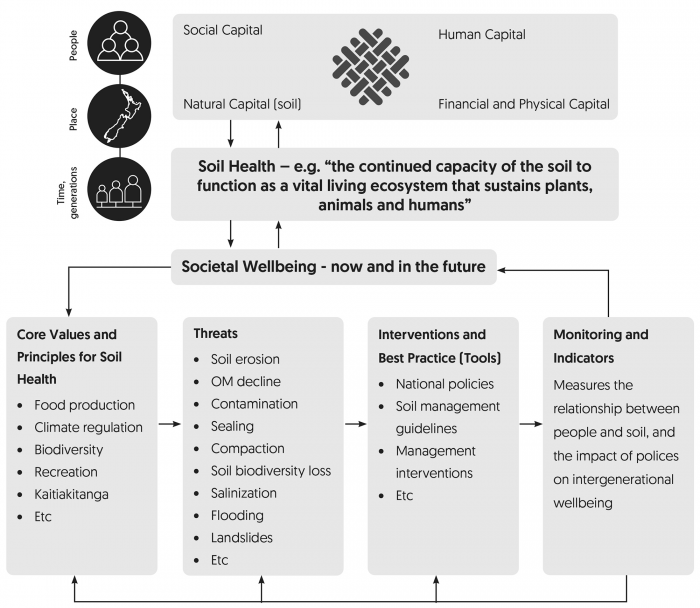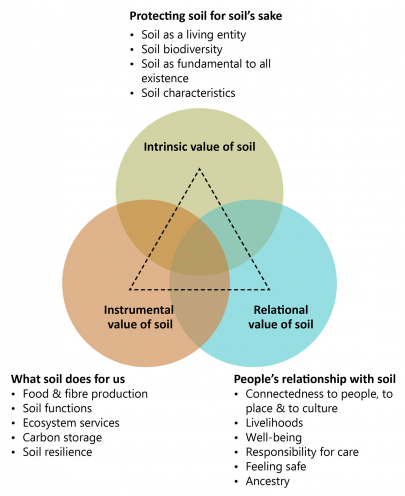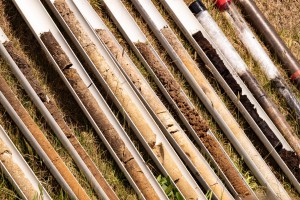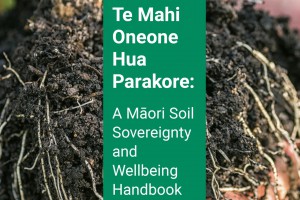Overview of the Soil Health & Resilience Programme – Oneone ora, Tangata ora
Soil, people and society
Overall, we learnt that we need to take a more holistic approach in how we manage soil(s) sustainably and write policy that reflects this because soil is a vital, life-giving ecosystem that sustains plants, animals, and people. Soil is an integral part of our social and cultural well-being, and the values that people hold about soil are multidimensional across society.
Te Ao Māori
Māori perspectives on soil health strongly connect soil to people and place. The Mātauranga Māori research enabled us to understand Te ao Māori values, Māori soil health concepts, identify indicators, and develop frameworks that could be used alongside those based on science knowledge and stakeholder values. Western-centric soil science knowledge and Mātauranga Māori both contribute and are important in managing soil sustainably. As a result of this project, we have more capacity to conduct Māori, social, and science research, which enables us to explore more holistic approaches to managing soil and achieving soil health.
Valuing soil(s) and soil health
We now have a better understanding of how stakeholders in the agricultural productive sectors express their relationship with soil and soil health. We took a well-being approach to soil health and developed a soil health framework that incorporated the Aotearoa New Zealand Treasury’s Living Standards Framework and intervention logic from Holloway (1993)[1] (See Fig. 1 and Stronge et al. 2020 for further information). The framework focuses on the well-being benefits that people get from soils and highlights the need to understand people’s core values for soil and soil health.

Figure 1. A soil health and well-being framework (from Stronge et al. 2020).

Figure 2: Nature Futures Framework applied to soil (adapted from PBL 2018. Report on the Workshop ‘Next Steps in Developing Nature Futures’. The Hague, Netherlands: Environmental Assessment Agency).
We found that there are multiple ways that people value soils and the benefits they derive from them. Using a Nature’s Future Framework lens these values can be represented as instrumental (what soil does for us), intrinsic (protecting soil for soil’s sake), and relational (people’s relationship with soil) (Fig. 2). Thematic analysis of interviews with 26 people with a connection to soil showed that people assign multiple values to soil(s) and soil health and all three value perspectives shown in Figure 1 are important (Kannemeyer et al. 2022).
Soil health and well-being framework
In the final year of the programme, our research on soil health values enabled us to further develop the soil health and well-being framework shown in Figure 1. This research brought together multiple worldviews and multi-dimensional soil values from across society.[2] The framework uses the ‘Waka Taurua’ bicultural model[3] to demonstrate the plurality of soil health and human well-being values from Māori and non-Māori in Aotearoa-New Zealand. The framework can be used to shape dialogue and understanding and to develop shared goals to maintain and enhance soil resources, soil health, and human well-being.
Soil health indicators
Soil health (and/or soil quality) indicators are defined as ‘measurable soil attributes that influence the capacity of soil to perform crop production or environmental functions’ (Arshad & Martin 2002[4]). The soil quality indicators from the 500 Soils programme developed in the 1990/2000s are minimum requirements for Aotearoa New Zealand State of the Environment (SOE) reporting. These indicators include pH, total carbon, total nitrogen, anaerobic mineralisable N, Olsen P (phosphorus), bulk density, and macroporosity (large pores), along with trace element analyses, e.g. cadmium, to assess anthropogenic inputs. This set of indicators is recognised internationally and has led to new knowledge about the state of soil health, e.g. low macroporosity, on dairy and intensive drystock land uses. These indicators have also led to improved land management practices. However, broader measures that relate to how soil functions in the environment and the services it provides, as well as recognition of the different ways in which soil is valued, need to be incorporated into these measures. Different soil indicators are needed for different purposes, e.g. visual soil assessment should be encouraged for less formal soil health evaluation.
Māori soil health indicators are based on Mātauranga Māori and science knowledge, and include central Māori concepts such as whakapapa, mana, mauri, kaitiakitanga, wairua, taonga tuku iho, oranga, mahinga kai/māra kai, and maramataka, to guide and assess soil management practices for achieving soil health (see glossary for these Māori concepts).
Resilience and health of soil
Soil properties vary, depending on the complexity and site-specificity of the soil, its legacy of previous land use, and trade-offs between the ecosystem services. Choosing which soil attributes to assess if a soil is healthy or fertile requires an assessment of a range of soil functions. Assessing the physical, chemical, and biological properties helps us understand how these attributes change over time and what effect these soil assessments have in relation to the services and benefits soil provides for humans, plants, and animals. Our research focused on better defining the health and resilience of our soils using land-use comparisons and other experimental approaches to measure different aspects of soil health. For example, we tested the effects of different forms of land-use intensification on soil properties to determine if pedogenic thresholds[5] were crossed due to land-use intensification.
We also analysed soil samples from the longest established controlled trial in New Zealand. Among the findings was that calcium is being replenished in the soil profile through soil amendments (lime, superphosphate), but that quantities of other plant-available nutrients – magnesium (Mg), potassium (K) – are decreasing under increasing phosphorus fertilisation and irrigation as production of above-ground dry matter increases. This depletion of Mg was also seen in changes to clay mineralogical structure as a decrease in interlayer cations. Elemental analyses, however, do not appear to show significant pedological shifts in soil structural components (e.g. iron, aluminium, and silica) in the soil profile.
Glossary
| Kaitiakitanga | Environmental guardianship |
| Mahinga kai/māra kai | The ability for nature and soil to produce and sustain healthy food for harvest, collection, and consumption. All food grown has a mauri |
| Mana | Authority to manage and make decisions but also can imply the mana of a soil as a living entity, i.e. food sovereignty, e.g. ability to make decisions over someone’s land; soil management guidelines; and best practice |
| Maramataka | The Māori lunar or moon calendar traditionally marks time and for example guides planting and harvesting of food supplies |
| Mauri | Internal essence, life force, assessment, local knowledge, e.g. a healthy functioning soil fit for purpose and sustaining life, health, and prosperity, capacity of a soil to function as a living system to sustain mauri |
| Oneone | Soil |
| Oneone ora | Ability of soil to provide and ensure the health and well-being of people in accordance with cultural values. Soil health and healthy soils |
| Oranga | Healthy, being healthy, well-being |
| Taonga tuku iho | Treasured possessions sustained or passed through generations, intergenerational guardianship |
| Wairua | The spiritual dimension to life, spiritual practice, soul |
| Whakapapa | Ancestral lineage, ancestral connections, genealogical relationships that link people, to place, land, and soil, reinforcing interconnections and interdependencies between and with all parts of nature |
Footnotes
[1] Holloway J 1993. Conservation pests: How can national values and objectives be quantified? New Zealand Journal of Zoology 20: 285–293.
[2] At the time of writing this article the new integrated framework that incorporates these pluralistic soil values has been submitted for publication (Stronge DC, Kannemeyer RL, Harmsworth G, Stevenson B (submitted). chieving soil health in Aotearoa New Zealand through a pluralistic values-based framework – mauri ora ki te whenua, mauri ora ki te tangata. Sustainability Science).
[3] Maxwell K, Awatere S, Ratana K, Davies K., Taiapa C 2020a. He waka eke noa/we are all in the same boat: A framework for co-governance from Aotearoa New Zealand. Marine Policy 121: 104213.
[4] Arshad MA, Martin S 2002. Identifying critical limits for soil quality indicators in agroecosystems. Agriculture, Ecosystems and Environment 88: 153–160.
[5] A pedogenic threshold occurs when there is an abrupt change and/or nonlinear increment in the soil properties.
Further reading
- pdf Kannemeyer RL, Stronge DC, Harmsworth GR, Stevenson BA 2022. Understanding connections between people and soil: how do people value soils? Manaaki Whenua – Landcare Research Contract Report LC4112 pdf File, 623 KB
- Stronge DC, Stevenson BA, Harmsworth GR, Kannemeyer RL 2020. A well-being approach to soil health – insights from Aotearoa New Zealand. Sustainability 12(18): 7719. Link
- pdf Stevenson B 2022. Soil health indicators. Manaaki Whenua – Landcare Research: Contract Report LC4166. pdf File, 1.3 MB


